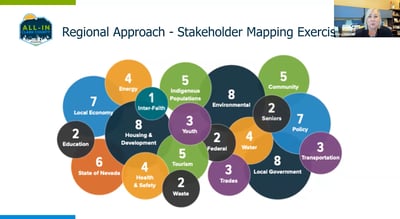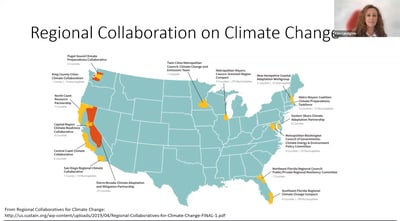
In July, KLA held a webinar to discuss regional climate action and collaboration in a new age of federal funding for sustainability and resilience planning. The fact that the webinar took place among record deadly heat across the country only underscores the need for smart, ambitious climate action.
Our expert panel, consisting of regional climate veterans from Clark County, NV and Washington, DC, discussed all things regional climate planning, from tips for regional GHG inventories to critical considerations for equitable engagement strategy.
Federal funding is abundant for regional climate action right now - over $5 billion is available for local, state, and regional bodies through the EPA’s Climate Pollution Reduction Grant (CPRG) program, part of the Inflation Reduction Act. Programs like CPRG can be game changers in the fight against climate change – and properly utilizing this funding can make or break a communities’ capability for innovation and resilience.
If you missed the webinar but are motivated to act on these federal funding opportunities, you can watch the webinar recording or download our CPRG tipsheet that hits some of the high notes when it comes to GHG inventories, equitable engagement, and stakeholder coordination. We’ve also pulled a key quote from each member of our webinar panel that gets to the core of the how and why of regional climate action.
Key Quotes from the CPRG Webinar:
"Regional collaboration on climate change is not new. There are many examples out there – things that we can learn from.”
- Kim Lundgren - CEO, Kim Lundgren Associates
While many communities are set to collaborate regionally on climate action for the first time, there are already years and years’ worth of strong examples of regional climate collaboration. For example, the Southeast Florida Regional Climate Change Compact has existed since 2010, and has created a fantastic case study for bringing together multiple stakeholders and counties for action. The Institute for Sustainable Communities’ Regional Collaboratives for Climate Change report includes other examples and models. When embarking on a regional climate action plan or initiative, utilize the wealth of knowledge created by those who have already experienced the trials and errors of the process.

“When it comes to creating inventories across state lines, I recommend not reinventing the wheel. Use data protocols and tools that are already available to you.”
- Maia Davis - Senior Environmental Planner, Metropolitan Washington Council of Governments
MWCOG staff has been conducting GHG inventories for over 20 years, meeting their first goal of 10% reduction in 2012, and their second goal of 20% reduction in 2020. A key to their success was knowing when it was necessary to scale data up or down and finding the best methods to collect pre-existing data.
Data protocols and tools to help with inventories are already available and accessible: ICLEI has ClearPath, EPA offers state, local, and tribal inventory tools, and there is a plethora of federal data that can be leveraged. You may also find that there is already existing data and reports that can be available already for your region. In the Metropolitan Washington region, MWCOG coordinated in-house with staff and with partner organizations that already had reports on solid waste, agriculture, air quality and more. To be most efficient, focus on using data that has already been collected as inputs for your inventory – and be sure to tap your contacts before recreating data that already exists.

“It’s really important to use this as an opportunity to learn about your community: understand what the sources of GHGs are, develop the knowledge needed to engage with diverse stakeholders, and establish the underlying context of your emissions.”
- Mike Steinhoff - Director of Climate Analysis, KLA
As many communities utilizing CPRG funding are creating regional GHG inventories for the first time, many might be wondering what the goals of these inventories should be. While of course, counting greenhouse gas emissions is the primary goal of these projects, focusing solely on emissions counts may lead communities to miss out on other information that will ultimately dictate if these processes fulfill the goal of CPRG funding. To avoid running into this problem, make sure to take a holistic look at your inventory throughout the process, using it as a baseline that will indicate what progress has been made after actions have been taken.

“There wasn’t necessarily one list of questions and boxes to tick when it came to environmental justice. Equity was a ‘North Star’ for Clark County throughout our entire planning process and engagement effort”
- Marci Henson - Director, Clark County Department of Environment and SustainabilityTo create their recently passed All-In Clark County Community Sustainability and Action Plan, Clark County, NV led the most equitable planning process in their history, engaging over 220,000 individuals and 70 organizations. Integral to this achievement was their stakeholder mapping process, in which the County facilitated conversations with existing partners and stakeholders to identify who was missing from the table. Truly equitable regional planning processes, like the one in Clark County, don’t only utilize existing connections: they seek out stakeholders who are missing from the table and actively give them space to have a voice in the planning process. The County plans to build on this legacy of equitable engagement by utilizing their CPRG funding to facilitate a county-wide education program surrounding sustainability and climate change.
Want to see more from past KLA webinars? Check out our Climate Solutions Webinar Series. If you want to be updated when KLA releases future webinars and resources, make sure to sign up for The Source, our monthly newsletter for all things local climate action.




